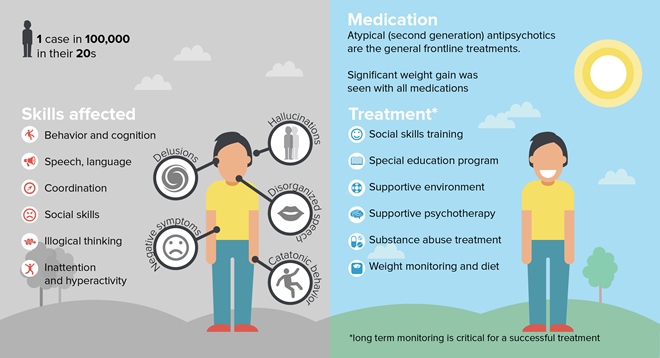Schizophrenia in Young Adults
(img source: https://www.psycom.net/childhood-schizophrenia)
Background On The Problem
Broderick & Blewitt tell us that young adulthood is not only marked by a large growth in knowledge and skills, but also the development of formal operational thinking. It's at this stage of development that we see the development of logical thinking in adult problem-solving. This is the acquisition stage in which young adults begin to acquire a body of knowledge upon which they build the cognitive foundations for their adult life, regardless of whether that information is relevant to their future family or work lives. As young adults develop, they begin to be held accountable for their views and actions (2020, p. 436). This is when adolescent schizophrenia starts to take hold. The first onset of symptoms deal directly with the newfound logical thinking found in burgeoning adults, and directly affects its development.
This article is meant as a guide for the families of young adults who are experiencing schizophrenia or symptoms related to schizophrenia spectrum disorders but haven't yet been diagnosed. Schizophrenia is a disorder that is characterized by an abnormal interpretation of reality. Childhood schizophrenia is largely the same as adulthood schizophrenia, but with the added impact of affecting the development of the child. It is a chronic condition that requires treatment and monitoring for the duration of the lifespan (Mayo Clinic Staff, 2021).
Symptoms
(Edwards, 2023)Early Intervention
Research shows that, for the best possible outcomes, it is important to make an early diagnosis of schizophrenia. Though it is exceedingly rare, an early diagnosis can make a massive difference in the outcome of your child's development. Bellomo et al. state that initiatives such as proper practitioner training, information campaigns in schools, providing information to families, and the advertising of specific access to high-risk children all favor an early diagnosis outcome in these cases (2023).
Further, there is an increasing amount of evidence for physical markers in the brain structure of children that indicate the onset of schizophrenia after their first episode of psychosis. Specifically, there are consistent maturational dysregulations that can be found as concrete evidence in the brain-anatomical network that, once found, facilitate early intervention through diagnosis (Li et al., 2019).
Early intervention is important because adolescents with schizophrenia are at major risk of psychopathology (Vita et al., 2022). Later in life, those diagnosed with adolescent schizophrenia have been known to exhibit symptoms of social withdrawal, secrecy, sadness, and low life-drive when compared to their adult-onset counterparts. This is heavily mitigated by rich non-family relationships early on in their lives. Those with high sex drives and high intelligence quotients also have significantly better prognoses in these aspects (Ślosarczyk, 2022).
It is important to monitor and support those affected with schizophrenia. It makes a lifelong difference!
As in most cases, treatment is best handled by a multi-faceted team of psychologists, educators, nurses, psychiatric rehabilitation technicians, and social service representatives, as well as pharmacological treatment. As the patient is a child, it is also important that the intensity of care should change with their development, and transitions between the levels should be as smooth as possible (Bellomo et al., 2023).
Therapeutically, Cognitive Behavioral Therapy has been found to aid in the management of schizophrenia-related symptoms, such as delusions and hallucinations. CBT helps the patient restructure their reality and call attention to hallucinations that don't quite make sense. Through CBT, patients can also build coping skills to help when dealing with the dysfunctional aspects of their condition (Vita et al., 2022). These coping skills are important for a patient to build, as they will provide ways to deal with every day stressors in work and school life, which can be exacerbated by schizophrenic symptoms.
For more information on CBT and schizophrenia, see the following:
Cognitive Behavioral Therapy for Schizophrenia by NYU Langone Health (n.d.)
Though irregular, many adolescent patients with schizophrenia have found electroconvulsive therapy to be a helpful treatment in addition to their medication and therapy. In a study by Flamarique et al., most patients voted ECT to be helpful with their symptom management, not outdated, cruel, and voted that it should not be an illegal practice moving forward (2015).
From therapeutic intervention, families can learn techniques to ground their adolescents in reality and notice signs of delusion or hallucination. Patients can learn to restructure their ideas about reality and ground them in logical thinking. Utilizing CBT coping skills can offer step-by-step processes in detecting hallucinations. "Is it possible to see what I just saw?" "Did anyone else hear what I just heard?" (Cognitive behavioral therapy, n.d.; Hallucinations, 2022).
Medication
The common effective medications for adolescents with schizophrenia are known as atypical antipsychotic medications. These medications are prescribed to treat the symptoms of mood swings, aggression, depression, and psychosis, all regularly exhibited with schizophrenia. These medications are popular due to their more subdued side effects (Arango et al., 2020). Here are some options for those with adolescent-onset schizophrenia:
Aripiprazole is a an atypical antipsychotic that has been found to be a safe and effective drug for the maintenance treatment of adolescents with schizophrenia. Aripiprazole represents a good option early in the course of the illness that combines good efficacy with acceptable safety and tolerability for adolescents (Correll et al., 2017).
Oral blonanserin is a medications that can be used seamlessly throughout adolescence and into adulthood. Blonanserin has a moderately lower risk of weight increase and better maintenance of metabolic parameters when compared to other schizophrenia medications (Saito et al., 2022).
Lurasidone treatment showed significantly less weight gain than that of quetiapine, olanzapine, risperidone, asenapine, or paliperidone in a comprehensive study while maintaining effectiveness when dealing with problematic symptoms. This is an effective medication for patients who are at risk of obesity and related weight-gain concerns (Arango et al., 2020).
Conclusion
Schizophrenia is a lifelong disorder that can have lasting effects on the quality of life of an individual. Despite this, there is an ever-growing body of research into effective treatments and ways to increase one's quality of life. As a family member, the best way to ensure the best treatment is to be aware of symptoms, get help as soon as you see an issue, and stay supportive. The best health outcomes happen in the presence of supportive loved ones!
Resources
- Arango, C., Ng-Mak, D., Finn, E., Byrne, A., & Loebel, A. (2020). Lurasidone compared to other atypical antipsychotic monotherapies for adolescent schizophrenia: a systematic literature review and network meta-analysis. European Child & Adolescent Psychiatry, 29(9), 1195–1205. https://doi-org.rivier.idm.oclc.org/10.1007/s00787-019-01425-2
- Ash, M. E. (2023, June 13). Childhood-onset schizophrenia treatment & management. Approach Considerations, Medical Care, Psychosocial Management. https://emedicine.medscape.com/article/914840-treatment?form=fpf#d6
- Bellomo, A., Masi, G., Vita, A., & Zuddas, A. (2023). Adolescent schizophrenia: state of the art and proposals to improve transition management in Italy. Rivista di psichiatria, 58(3), 101–109. https://doi.org/10.1708/4056.40381
Broderick, P. C., & Blewitt, P. (2020). The Life Span: Human Development for Helping Professionals. Pearson Education, Inc.
Hallucinations: Definition, causes, treatment & types. Cleveland Clinic. (2022, June 26). https://my.clevelandclinic.org/health/symptoms/23350-hallucinations
- Cognitive behavioral therapy for schizophrenia. Patient Care at NYU Langone Health. (n.d.). https://nyulangone.org/conditions/schizophrenia/treatments/cognitive-behavioral-therapy-for-schizophrenia
- Correll, C. U., Kohegyi, E., Zhao, C., Baker, R. A., McQuade, R., Salzman, P. M., Sanchez, R., Nyilas, M., & Carson, W. (2017). Oral Aripiprazole as Maintenance Treatment in Adolescent Schizophrenia: Results From a 52-Week, Randomized, Placebo-Controlled Withdrawal Study. Journal of the American Academy of Child & Adolescent Psychiatry, 56(9), 784–792. https://doi-org.rivier.idm.oclc.org/10.1016/j.jaac.2017.06.013
- Edwards, R. (2023, September 4). Early signs and symptoms of schizophrenia. Verywell Health. https://www.verywellhealth.com/early-signs-schizophrenia-5101519
- Flamarique, I., Castro-Fornieles, J., de la Serna, E., Pons, A., Bernardo, M., & Baeza, I. (2015). Patients' opinions about electroconvulsive therapy: What do adolescents with schizophrenia spectrum disorders think? Journal of Child and Adolescent Psychopharmacology, 25(8), 641–648. https://doi.org/10.1089/cap.2015.0113
- Li, M., Becker, B., Zheng, J., Zhang, Y., Chen, H., Liao, W., Duan, X., Liu, H., Zhao, J., & Chen, H. (2019). Dysregulated maturation of the functional connectome in antipsychotic-naïve, first-episode patients with adolescent-onset schizophrenia. Schizophrenia Bulletin, 45(3), 689–697. https://doi-org.rivier.idm.oclc.org/10.1093/schbul/sby063
- Mayo Clinic Staff. (2021, May 19). Childhood schizophrenia. Mayo Clinic. https://www.mayoclinic.org/diseases-conditions/childhood-schizophrenia/symptoms-causes/syc-20354483
- Rhesus Medicine. (2022, August 15). Schizophrenia explained (includes DSM-5 criteria & delusion examples). YouTube. https://www.youtube.com/watch?v=0zHU6fiM2KY
- Saito, T., Hyodo, Y., Sakaguchi, R., Nakamura, H., & Ishigooka, J. (2022). Long-term safety and efficacy of blonanserin oral tablet in adolescents with schizophrenia: A 52-week, multicenter, open-label extension study. Journal of Child and Adolescent Psychopharmacology, 32(1), 24–35. https://doi-org.rivier.idm.oclc.org/10.1089/cap.2021.0058
- Ślosarczyk, M., Ślosarczyk, K., & Furgał, M. (2022). A 45-year follow-up study of adolescent schizophrenia. Part I: Premorbid values of psychological and relational indicators in the context of illness course and long-term social functioning of patients. Psychiatria Polska, 56(1), 19–34. https://doi-org.rivier.idm.oclc.org/10.12740/PP/OnlineFirst/125745
- Tracy, N. (2015, February 28). What is childhood-onset schizophrenia? Canadian Pharmacy King. https://www.canadianpharmacyking.com/KingsBlog/What-is-ChildhoodOnset-Schizophrenia/
- Vita, A., Barlati, S., Bellomo, A., Poli, P. F., Masi, G., Nobili, L., Serafini, G., Zuddas, A., & Vicari, S. (2022, March 8). Patterns of care for adolescent with schizophrenia: A Delphi-based consensus study. Frontiers. https://www.frontiersin.org/journals/psychiatry/articles/10.3389/fpsyt.2022.844098/full

:max_bytes(150000):strip_icc():format(webp)/early-signs-schizophrenia-5101519_final-6861147c5e4e4a09956011952057ba72.jpg)

Comments
Post a Comment